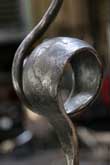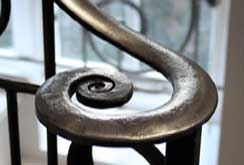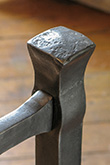Burnished and Waxed Steel |
"... Verdigris; where engineering becomes art ..."
The surface of forged
steel has a rich character full
of tone and texture. However, it will tarnish if the steel gets wet and
it be should protected with a barrier coating. Clear lacquer can be used but
it does tend to mask some of the surface's nuances and character, it is
also difficult to reapply. Blacksmiths prefer to use a wax coating to protect
their work.
The steel is first cleaned and burnished with a wire brush, then a special wax paste is rubbed onto its surface with a cloth. This soon hardens to a tough clear finish which does not easily rub off and is easy to reapply.
The traditional method of protecting forged
steel was to use beeswax but this will yellow with age. A much more effective
and aesthetically pleasing modern wax is
Renaissance Wax; a synthetic microcrystalline
and non yellowing wax developed by the British
Museum. This is used to protect their suits of armour and other metalwork,
it also has a Royal Warrant!
Forged steel protected with wax has a grey black variegated appearance but if a more uniform grey is required we can have the steel sand blasted before it is burnished.
Certain items such as handrails are often regularly handled, and over a period of time their wax coating may eventually wear away. Unlike paint or lacquer, it is relatively quick and easy to reapply the wax.
If the steel has lightly rusted or tarnished, it can be cleaned with fine
wire wool (or scotchbrite) then re-waxed. Just like fine furniture, forged
steel needs care and maintenance, though only rather infrequently.


